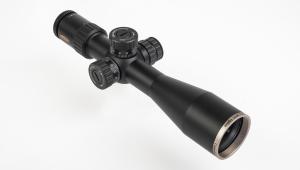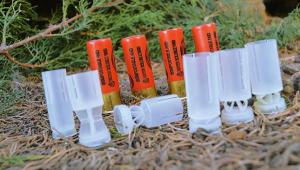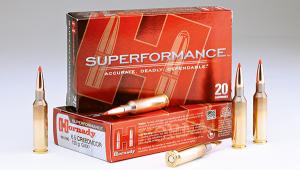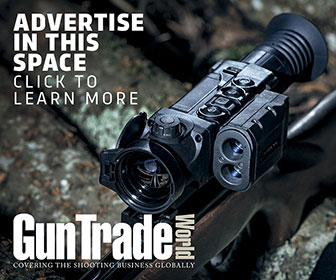No shooting without ammo

AMMUNITION TYPES
In this feature we consider metallic rifle and handgun ammunition next to shotgun cartridges. As we all know ammo is a type of pre-assembled packaging featuring a projectile (a bullet or shot), a propellant (gun powder) with a case (metallic, plastic or paper) that is precisely made to fit within a gun’s chamber. When considering metallic ammunition, two essential types spring to mind: rimfire and centerfire, categorizing them by the type of their primers. Shotgun shells meanwhile all share the same typical construction, regardless of their gauge.
SHOTGUN SHELLS
Modern shotgun shells typically consist of a plastic case, with the base covered in a thin metal covering. In the past shells with a paper case used to be common. While these are still made today, shooters tend to prefer plastic cases as these are far more resistant to the elements. The base of the shell is fairly thick to hold the large shotgun primer. The powder itself takes relatively little space in the shell. After the powder comes the wad. The primary role of a shotgun wad is to prevent the mixing of propellants and pellets in a shotshell. The wad forms a critical gas seal at firing to keep the expanding gases behind the shot charge. Wads also act as spacers, setting the correct volume for the propellant and shot charges and cushioning the pellets to reduce deformation. Conventional fiber wads continued to be used after plastic shot wrappers appeared. Eventually hard-to-load plastic sheet material was replaced with an easily installed shot cup that was closed at the bottom. Molded wads soon became commonplace. The evolution of wad design integrated the skirted base, pellet cushioning, and the pellet wrapper into one molded unit. Throughout the years, as society is rethinking ways to decrease plastic pollution, many companies have come up with viable alternatives for non-degradable plastic wads. These biodegradable wads tend to be either water soluble or photodegradable. The shot cup is the last part of the shell, and it serves to hold the shot together as it moves down the barrel. Shot cups have slits on the sides so that they peel open after leaving the barrel, allowing the shot to continue on in flight undisturbed. The shot fills the shot cup (which must be of the correct length to hold the desired quantity of shot), and the shotgun shell is then crimped, or rolled closed. The shot in a shotgun shell is traditionally made of lead, but other metals such as steel, copper, tungsten and bismuth are also used due to restrictions on the use of lead in some areas. Next to shot, a shotshell can also contain a single, large solid projectile, known as a slug. Shotgun ammo account for 35 percent of sales as quoted by the retailers in our survey.
RIMFIRE CARTRIDGES
First up in the metallic cartridge segment is the popular rimfire. The ongoing importance of rimfire sales for gun shops cannot be underestimated. As the majority of rimfire sales is destined for classic plinking and recreational shooting, hunting ammo still accounts for about one third of sales while competition and target shooting amount to a more modest part of sales.
In rimfire the firing pin strikes and crushes the rim of the round to ignite the primer inside. The rim will display a telltale mark where it has been struck. Essentially the whole inside edge of the cartridge is one big, flattened primer. The advantage to this design is that it is relatively cheap to manufacture. However the nature of the casing means the design is generally limited to smaller calibres, since the brass casing has to be less robust and it would be destroyed by an explosion of a large amount of propellant needed for a bigger projectile. This is why you will typically only see rimfire ammunition in .17 and .22 calibers. Compared to centerfire ammunition, another disadvantage is that the nature of the rimfire cartridge design means the case is permanently deformed and, therefore, is unsuitable for reloading. Despite its construction limitations, rimfire ammunition does remain the most used ammo type across the globe.
CENTERFIRE CARTRIDGES
With centerfire ammunition the gun’s firing pin strikes the primer cap in the middle of the cartridge base to ignite the powder and propel the bullet forward. Compared to a rimfire cartridge, the centerfire cartridge has numerous advantages. Not only can you produce much bigger rounds because the casing is far more robust, centerfire also implies it is only the primer in the middle that gets damaged when firing. As a consequence, the empty metallic cartridge casing can be used over and over again after firing. centerfire ammunition is also felt to be more reliable and offers a much bigger variety in calibers, loads and available bullet types.
Contrary to rimfire ammunition, hunting accounts for the majority of sales in the centerfire ammunition category. Just a limited part of sales goes to plinking and recreational shooting while competition and target shooting accounts for only a small part of sales as well. This divide remains largely stable throughout the years. It goes without saying that centerfire rifle ammunition has a big impact on overall sales in the gun shops we questioned.
PRICE
When asked about the main factors in a buyer's choice of ammunition, performance rules supreme. No less than 57 percent of the retailers in our survey state performance as being a decisive factor. Price comes in second, followed by availability and brand/make. This result clearly has a lot to do with the question being posed about the ammunition market in general. In recent years our surveys showed performance is the prime reason to buy in the centerfire ammunition market as opposed to price, definitely price, in the rimfire ammunition market.
VITAL
Looking back to the last twelve months, no less than 50 percent of the retailers in our survey claim ammunition sales to have risen. A further 15 percent mentions sales are stable. When asked about the importance of ammunition sales for the overall business of the retailers in our survey, over 92 percent claim ammunition sales to be ‘very important’. For 64 percent of retailers, up to 40 percent of their business consists of ammunition sales. A further 21 percent quote an even higher percentage of their overall sales come from ammunition. All this to underline the overall importance of the ammunition market for the gun trade. The need for ongoing supplies of ammunition provides an important link between retailers and consumers by ensuring regular contact and, in the end, creating a real bond with customers.
- Log in or register to post comments

















